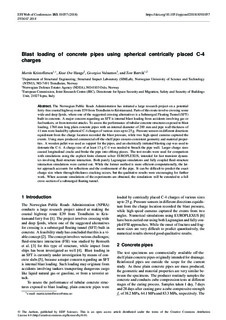| dc.contributor.author | Kristoffersen, Martin | |
| dc.contributor.author | Hauge, Knut Ove | |
| dc.contributor.author | Valsamos, Georgios | |
| dc.contributor.author | Børvik, Tore | |
| dc.date.accessioned | 2019-01-28T11:46:07Z | |
| dc.date.available | 2019-01-28T11:46:07Z | |
| dc.date.created | 2018-09-15T21:08:54Z | |
| dc.date.issued | 2018 | |
| dc.identifier.isbn | 978-2-7598-9053-8 | |
| dc.identifier.uri | http://hdl.handle.net/11250/2582611 | |
| dc.description.abstract | The Norwegian Public Roads Administration has initiated a large research project on a potential ferry-free coastal highway route E39 from Trondheim to Kristiansand. Parts of this route involve crossing somewide and deep fjords, where one of the suggested crossing alternatives is a Submerged Floating Tunnel (SFT)built in concrete. A major concern regarding an SFT is internal blast loading from accidents involving gas orfuel tankers, or from terrorist attacks. To assess the performance of tubular concrete structures exposed to blastloading, 1760 mm long plain concrete pipes with an internal diameter of 200 mm and pipe wall thickness of41 mm were loaded by spherical C-4 charges of various sizes up to 25 g. Pressure sensors in different directionsequidistant from the charge location recorded the blast pressure, while two high-speed cameras captured theevents. Using mass produced commercial off-the-shelf pipes ensures consistent geometry and material proper-ties. A wooden pallet was used as support for the pipes, and an electrically initiated blasting cap was used todetonate the C-4. A charge size of at least 13 g C-4 was needed to breach the pipe wall. Larger charge sizescaused longitudinal cracks and broke the pipe into oblong pieces. The test results were used for comparisonwith simulations using the explicit finite element solver EUROPLEXUS, intended for fast transient dynam-ics involving fluid-structure interaction. Both purely Lagrangian simulations and fully coupled fluid-structureinteraction simulations were carried out. While the former method is more efficient computationally, the lat-ter approach accounts for reflections and the confinement of the pipe. It can be difficult to predict the exactcharge size where through-thickness cracking occurs, but the qualitative results were encouraging for furtherwork. When accurate simulations of the experiments are obtained, the simulations will be extended to a fullcross-section of a submerged floating tunnel. | nb_NO |
| dc.language.iso | eng | nb_NO |
| dc.publisher | EDP Sciences | nb_NO |
| dc.relation.ispartof | DYMAT 2018 - 12th International DYMAT Conference on the Mechanical and Physical Behaviour of Materials under Dynamic Loading | |
| dc.rights | Navngivelse 4.0 Internasjonal | * |
| dc.rights.uri | http://creativecommons.org/licenses/by/4.0/deed.no | * |
| dc.title | Blast loading of concrete pipes using spherical centrically placed C-4 charges | nb_NO |
| dc.title.alternative | Blast loading of concrete pipes using spherical centrically placed C-4 charges | nb_NO |
| dc.type | Chapter | nb_NO |
| dc.description.version | publishedVersion | nb_NO |
| dc.source.volume | 183 | nb_NO |
| dc.identifier.doi | 10.1051/epjconf/201818301057 | |
| dc.identifier.cristin | 1609837 | |
| dc.description.localcode | © The Authors, published by EDP Sciences, 2018. This is an Open Access article distributed under the terms of the Creative Commons Attribution License (http://creativecommons.org/licenses/by/4.0), which permits unrestricted use, distribution, and reproduction in any medium, provided the original work is properly cited. | nb_NO |
| cristin.unitcode | 194,64,45,0 | |
| cristin.unitname | Institutt for konstruksjonsteknikk | |
| cristin.ispublished | true | |
| cristin.fulltext | original | |

